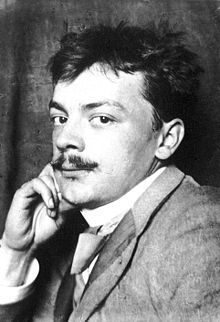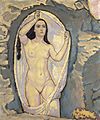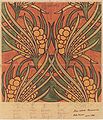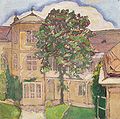Koloman Moser
Koloman Moser | |
|---|---|
 Photograph of Koloman Moser (1905) | |
| Born | 30 March 1868 |
| Died | 18 October 1918(aged 50) Vienna, Austria-Hungary |
| Education | 1885–1892Academy of Fine Arts Vienna 1893–1895Vienna School of Applied Arts(Kunstgewerbeschule) |
| Known for | Painting,Drawing,Postage Stamp,Printmaking,Ceramics,Stained glass |
| Notable work | founder of theWiener Werkstätte,Stained glass ofKirche am Steinhof |
| Movement | Vienna Secession,Jugendstil |
Koloman Moser(German:[ˈkoːlomanˈmoːzɐ];30 March 1868 – 18 October 1918) was an Austrian artist who exerted considerable influence on twentieth-century graphic art. He was one of the foremost artists of theVienna Secessionmovement and a co-founder ofWiener Werkstätte.
Moser designed a wide array of art works, including books and graphic works frompostage stampsto magazine vignettes; fashion; stained glass windows, porcelains and ceramics, blown glass, tableware, silver, jewelry, and furniture.
Biography
[edit]Moser was born inViennain 1868 to parents Josef and Thresia Moser (née Hirsch); he was the oldest of three siblings. studied at theWiener Akademieand theKunstgewerbeschule,where he also taught from 1899.
Moser's designs in architecture, furniture, jewellery, graphics, and tapestries helped characterise the work of this era. He drew upon the clean lines and repetitive motifs of classical Greek and Roman art and architecture in reaction to the Baroque decadence of his turn-of-the-century Viennese surroundings. Between 1900 and 1902, he published withMartin GerlachandCarl Otto Czeschkaa three volume portfolio titledDie Quelle( "The Source" ) of elegant graphic designs for such things as tapestries, fabrics, and wallpaper.[1]
In 1903, Moser and his colleagueJosef HoffmannfoundedWiener Werkstätte,whose studios and artisans produced a number of aesthetically and functionally designed household goods, including glassware, flatware, silverware, rugs[2][3]and textiles. In 1904, he created theApsemosaicand glass windows for theKirche am Steinhofin Vienna, and designed the decoration of the Medallion House of theLinke Wienzeile Buildingsfor architectOtto Wagner.
In 1905, together with theKlimtgroup, he separated from theVienna Secession.The same year, he marriedEditha (Ditha) Mautner von Markhof,an artist in her own right as well as the daughter to one of Austria's great industry fortunes. Due to internal conflicts and as his plans for reorganising the Werkstätte (to cope with financial problems) weren't realised, Moser withdrew from the Wiener Werkstätte in 1907.
Moser became ill with throat cancer in 1916. Correspondence withAlfred Rollerdetailed Moser's despair over who would succeed to his position at theUniversity of Applied Arts Vienna.Moser died on 18 October 1918; he was buried three days later in theHietzing Cemetery.
Legacy
[edit]Moser was the lead designer for Austria's leading art journalVer Sacrum(‘Sacred Spring’ in Latin),the official magazine of the Vienna Secession from 1898 to 1903. This art journal paid great attention to art and design and was managed mainly by Moser, Gustav Klimt and Josef Hoffmann.[4]
One of Moser's most prominent designs used in a building (The Steinhof Church) was selected as a main motif of one of the most famous euro collectors coins: the Austrian 100 euroSteinhof Church commemorative coin,minted on 9 November 2005.[5]On the reverse of the coin, the Koloman Moser stained glass window over the main entrance can be seen. In the centre of the window is God the Father seated on a throne. The window is flanked with a pair of bronze angels inJugendstilstyle, originally designed byOthmar Schimkowitz.[5]
On 3 May 2010,Swann Galleriesauctioned the third volume in Moser's three-volume series "Die Quelle," containing 30 sumptuous decorations for flat surfaces, such as tapestries, wallpaper and fabrics, in the original portfolio. Each plate was double-sided, with a colour design on one side and a black-and-white design on the other. It sold for an auction record price of $12,600.[6]
To commemorate the centennial of his death, theMuseum of Applied Arts Vienna (MAK)honored Moser with one of the most comprehensive solo shows to date (19 December 2018-22 April 2019).[7]
Gallery
[edit]-
Bookcase
-
Inlaid Armorie
-
Armchair
-
1903
-
Poster for 'Frommes Kalender', 1899, color lithograph
-
Venus in the Grotto,ca. 1914
-
Artwork 'Ambilech' forJoh. Backhausen & Söhne,1899
-
1911
-
1912
-
Set design for "Das Phantom"
-
Emperor Franz Joseph on stamp by Kolo Moser 1908
-
Austrian-Hungarian 50 Crown Banknote by Kolo Moser 1911
Notes
[edit]- ^Rosenman, Roberto."DIE QUELLE -".Retrieved2024-03-27.
- ^Fanelli, Giovanni; Bonito Fanelli, Rosalia (1976).Il Tessuto Moderno: Disegno moda architettura 1890-1940.Florence: Valecchi, Firenze.
- ^Baroni, Daniele (1984).Kolo Moser. Graphic Artist and Designer.New York: Rizzoli. p. 72, 109.ISBN0-8478-0667-7.
- ^Rosenman, Roberto."VER SACRUM -".Retrieved2024-03-25.
- ^ab"Austrian Mint - Commemorative coins".2010-09-22. Archived fromthe originalon 2010-09-22.Retrieved2024-03-31.
- ^"KOLOMAN MOSER (1868 1918) DIE QUELLE FLÄCHENSCHMUCK 30 colo".catalogue.swanngalleries.com.Retrieved2024-03-28.
- ^"Koloman Moser - MAK Museum Vienna".www.mak.at.Retrieved2018-11-23.
Bibliography
[edit]- Stefan Üner: Koloman Moser. The Photographic Eye, in:PhotoResearcher,No 31, Vienna 2019, p. 134–147.
- Stefan Üner: Die Kunst der Präsentation. Koloman Moser als Ausstellungsdesigner, in:Parnass,4/2018, p. 22–24.
- Stefan Üner:The Art Of Presentation. Koloman Moser As Exhibition Designer,Dissertation. University of Applied Arts Vienna, Vienna 2016
- Fenz, Werner (1984).Koloman Moser.Salzburg: Residenz Verlag.ISBN3-7017-0369-8.
- Leopold, Rudolph;Gerd Pichler (2007).Koloman Moser: 1868-1918.Catalog of the Kolo Moser exhibition in theLeopold Museum(25 May 2007–10 September 2007). Munich: Prestel Publishing.ISBN978-3-7913-3879-8.
- Moser, Koloman (1998).Turn-of-the-Century Viennese Patterns and Designs.DoverPictorial Archives. New York: Dover Publications.ISBN978-0-486-40269-7.
- Rennhofer, Maria (2002).Koloman Moser: Master of Viennese Modernism.London: Thames & Hudson.ISBN978-0-500-09306-1.
- Salm-Salm, Marie-Amelie (2005).Klimt, Schiele, Moser, Kokoschka.Paris: Editions de la Réunion des musées nationaux.ISBN0-85331-934-0.
- Staggs, Janis (2008).Wiener Werkstatte Jewelry.Ostfildern-Ruit: Hatje Cantz.ISBN978-3-7757-2165-3.
- Thun-Hohenstein, Christoph; Witt-Dörring, Christian; Schmuttermeier, Elisabeth eds. (2019)Koloman Moser. Universalkünstler zwischen Gustav Klimt und Josef Hoffmann/Universal Artist between Gustav Klimt and Josef Hoffmann,exhibition catalogue for the MAK/Austrian Museum of Applied Art, Birkhäuser, Basel.ISBN978-3-0356-1849-5.
- Witt-Dörring, Christian, ed. (2013)Koloman Moser. Designing Modern Vienna 1897/1907,exhibition catalogue for the Neue Galerie New York, Prestel Verlag, New York.ISBN978-3-7913-5294-7.
External links
[edit]- 1868 births
- 1918 deaths
- Artists from Vienna
- Austrian stamp designers
- Austrian graphic artists
- Austrian designers
- Austrian illustrators
- Deaths from cancer in Austria-Hungary
- Academy of Fine Arts Vienna alumni
- Members of the Vienna Secession
- Art Nouveau designers
- Art Nouveau illustrators
- Wiener Werkstätte
- Artists from Austria-Hungary












